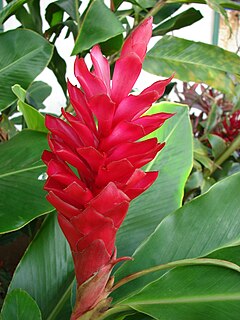
The Zingiberales are flowering plants forming one of four orders in the commelinids clade of monocots, together with its sister order, Commelinales. The order includes 68 genera and 2,600 species. Zingiberales are a unique though morphologically diverse order that has been widely recognised as such over a long period of time. They are usually large herbaceous plants with rhizomatous root systems and lacking an aerial stem except when flowering. Flowers are usually large and showy, and the stamens are often modified (staminodes) to also form colourful petal-like structures that attract pollinators.

Heliconia, derived from the Greek word Ἑλικώνιος, is a genus of flowering plants in the monotypic family Heliconiaceae. Most of the ca 194 known species are native to the tropical Americas, but a few are indigenous to certain islands of the western Pacific and Maluku. Many species of Heliconia are found in the tropical forests of these regions. Most species are listed as either “vulnerable” or “data deficient” by the IUCN Red List of threatened species. Several species are widely cultivated as ornamentals, and a few are naturalized in Florida, Gambia and Thailand. Common names for the genus include lobster-claws, toucan beak, wild plantains or false bird-of-paradise. The last term refers to their close similarity to the bird-of-paradise flowers (Strelitzia). Collectively, these plants are also simply referred to as heliconias.

Heliconia chartacea is a species of Heliconia native to tropical South America.

Heliconia acuminata is a species of plant in the family Heliconiaceae. It is an erect herb, typically growing 1.6 m tall, native to the South American countries of Brazil, French Guiana, Guyana, Suriname, Venezuela, Colombia, Bolivia and Peru. It is also grown as an ornamental plant in other regions.
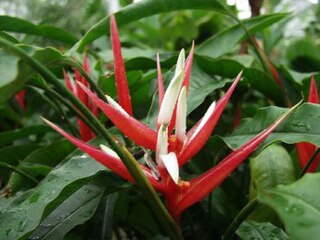
Heliconia angusta Vell., of Heliconiaceae family is an erect herb typically growing 0.70 m tall, native to Brazil.

Heliconia bihai of the Heliconiaceae family is an erect herb typically growing taller than 1.5 m. It is native to northern South America and the West Indies. It is especially common in northern Brazil and the Guianas but also found in Hispaniola, Jamaica, the Lesser Antilles, Puerto Rico, Trinidad, Venezuela and Colombia. Other names by which the plant is commonly known include balisier and macawflower.
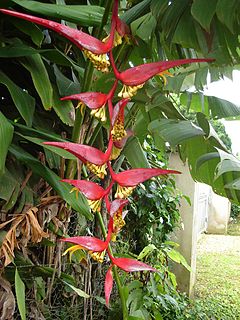
Heliconia collinsiana (platanillo) of Heliconiaceae family is an erect herb typically growing 10–15 feet (3.0–4.6 m) tall, native to Guatemala, Honduras, El Salvador, Nicaragua and southern Mexico.

Heliconia episcopalis is a species of plant in the family Heliconiaceae. It is an erect herb typically grows up to 2 meters tall, native to the Amazon Rainforest, in Colombia, Venezuela, Guyana, French Guiana, Suriname, Brazil, Ecuador, and Peru in South America.

Heliconia hirsutais a species of flowering plant in the family Heliconiaceae. This plant is an erect herb up to 2 m tall, and it is native to Central America, South America, and the Caribbean, from Belize to Trinidad to Argentina.
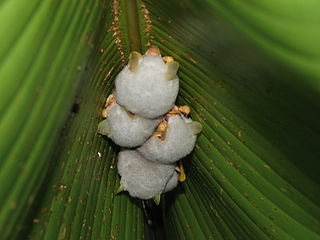
The Honduran white bat, also called the Caribbean white tent-making bat, is a species of bat in the family Phyllostomatidae. It is the only member of the genus Ectophylla. The genus and the species were both scientifically described for the first time in 1892. It has distinctive, entirely white fur, which is only found in six of the roughly 1,300 known species of bat. It constructs "tents" out of understory plant leaves by strategically cutting the leaf ribs with its teeth; it roosts in these tents during the day. It is a specialist frugivore, consuming almost exclusively the fruits of one species of fig. Females can likely become pregnant twice per year, giving birth to one offspring at a time.

The long-billed hermit is a large hummingbird that is a resident breeder from central Mexico south to northwestern Colombia, extreme western Venezuela and western Ecuador. This species was formerly known as the western long-tailed hermit or just long-tailed hermit, but was renamed to highlight its unusual bill.
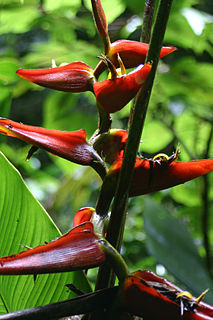
Heliconia tortuosa is an herbaceous tropical perennial commonly found in secondary succession in montane forests in Central America and southern Mexico. It is moderately shade tolerant. It has also been widely cultivated as a garden plant for its showy, usually twisted inflorescences.
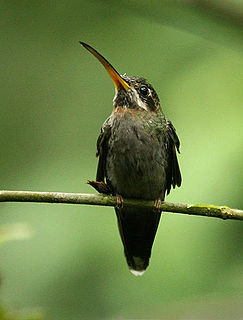
The band-tailed barbthroat is a medium-sized hummingbird which is a resident breeder from southeastern Guatemala and Belize to western Ecuador and western Venezuela.

Heliconia rostrata is an herbaceous perennial native to Peru, Bolivia, Colombia, Costa Rica, and Ecuador, and naturalized in Puerto Rico. Other Heliconias grow in the upright position, their cup-shaped flower bracts storing water for birds and insects. This plant, however, has downward-facing flowers, the flowers thus providing a source of nectar to birds.

Caligo eurilochus, the forest giant owl, is an owl butterfly ranging from Mexico, through Central America, to the Amazon River basin in South America. The type locality is Suriname.
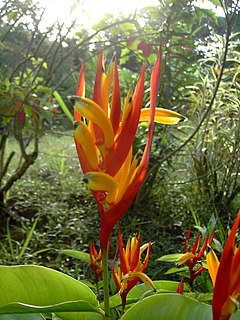
Heliconia psittacorum is a perennial herb native to the Caribbean and South America. It is considered native to French Guiana, Guyana, Suriname, Venezuela, Colombia, Bolivia, Brazil, Paraguay, Panama and Trinidad and Tobago. It is reportedly naturalized in Gambia, Thailand, Puerto Rico, Hispaniola, Jamaica and the Lesser Antilles. It is often cultivated as a tropical ornamental plant in regions outside its native range. Unlike most species of plants that require the use of pollinators for pollination the H. Psittacorum naturally prefers the absence of pollinators for pollination. In other words, it is well capable of pollinating itself, any use of pollinators can do more harm than good. The flower has both male parts (anthers) and female parts, also referred to as a hermaphroditic angiosperm.<ref>Aristeguieta, Leandro. 1961. El Género Heliconia en Venezuela no. 16a, Heliconia psittacorum var. rhizomatosa
Tithraustes noctiluces is a moth of the family Notodontidae. It is found in Panama, Costa Rica and El Salvador.

Dunama jessiebarronae is a moth in the family Notodontidae. It is found in Costa Rica, where it is only known from the eastern slopes of the Cordillera Volcanica de Guanacaste, Cordillera Volcanica Central, Cordillera de Talamanca, llanuras de Sarapiqui, and the lowlands of the Caribbean, at elevations ranging from 50 to 1,115 meters.

Dunama indereci is a moth in the family Notodontidae. It is found in Costa Rica, where it is known from the Villa Blanca, in San Ramon, Alajuela province, at an elevation of 1,115 meters in a montane pass between Costa Rica’s Cordillera de Tilaran and the Volcanica Central.
Heliconia vellerigera is a plant species in the family Heliconiaceae, native to Colombia, Ecuador, Peru and Costa Rica. It is a large herb up to 6 m tall with a pendulous inflorescence of 20-30 red-orange bracts covered with cinnamon-colored hairs.






